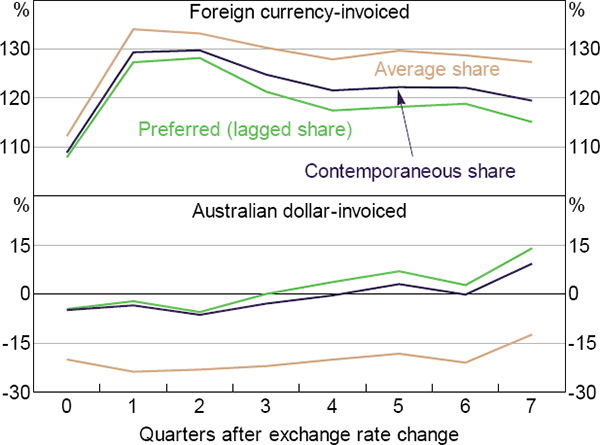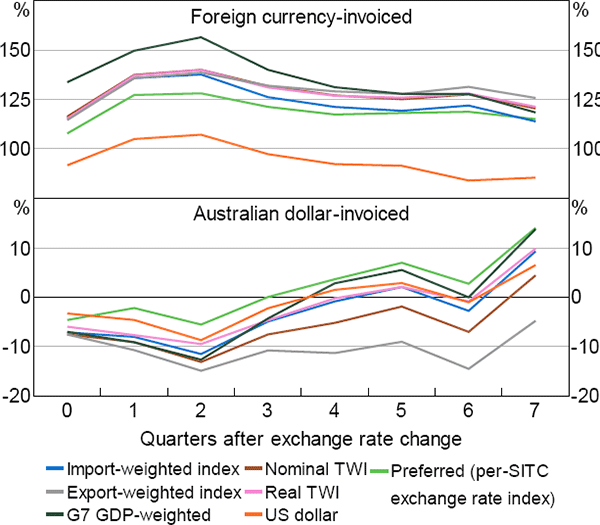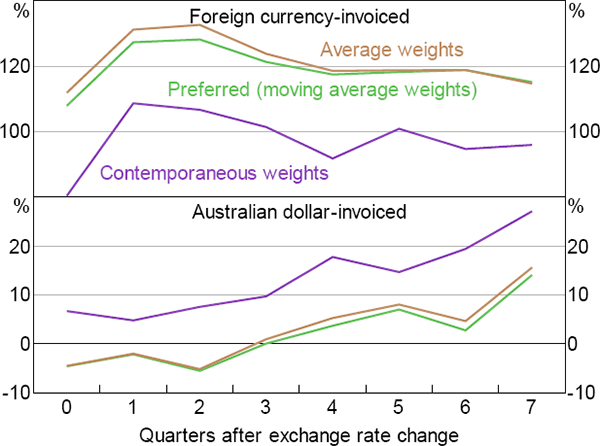RDP 2016-05: Trade Invoicing Currency and First-stage Exchange Rate Pass-through Appendix A: Robustness Checks
June 2016
- Download the Paper 1.10MB
As a robustness check on the way we incorporate information about invoicing currency we estimated two alternative models: one which incorporated the full-period-average Australian dollar-invoice share; and one which used the contemporaneous Australian dollar-invoice share, rather than the lagged share. Formally, the average-share model is:
and the contemporaneous share model is:
This choice does not substantially change our results (Figure A1). The average-share model produces negative estimates of pass-through for Australian dollar-invoiced goods and higher estimates of pass-through for foreign currency-invoiced goods. We suspect this result is due to the upward drift in the share of Australian dollar-invoiced goods shown in Figure 1.

Using different measures of exchange rates does not meaningfully alter the results either (Figure A2). Although there are differences in the point estimates, our broad result – that pass-through is roughly complete for foreign currency-invoiced goods and near zero for Australian dollar-invoiced goods – is unchanged.

In addition to our preferred two-digit SITC-level exchange rate indices in the text, we also used two other measures for determining the weights for these indices as a robustness exercise: one where the weights are based on the full sample average, rather than the time-varying moving average; and one where we use the contemporaneous import share, rather than the 12-month moving average. We refer to these as ‘average weights’ and ‘contemporaneous weights’. Our results are robust to this methodological choice (Figure A3).

Our final robustness check was to include time fixed effects in the pass-through regression instead of including quarterly GDP growth (Figure A4). Using time fixed effects shifts the level of pass-through, largely because of the effect on the contemporaneous coefficient. This means we find strongly negative pass-through for Australian dollar-invoiced goods. The level shift similarly affects both the foreign currency-invoiced coefficients and the Australian dollar-invoiced coefficients, such that the difference in pass-through between Australian dollar-invoiced goods and foreign currency-invoiced goods is mostly unaffected.
Given that the time fixed effects remove all the (substantial) common variation in the SITC-level exchange rates, it is not surprising that time fixed effects greatly affect our estimates of the level of pass-through. It is the substantial variation in the exchange rate (e.g. Figure 2, and as discussed in Section 2.3) that allows us to estimate the overall level of pass-through. That our estimate of the difference between foreign currency-invoiced and Australian dollar-invoiced pass-through is unaffected is thus reassuring, even if the level is not. Moreover, we have no good reason to believe that we have omitted important aggregate-level variables that might affect our estimates. Thus, the case for including time fixed effects is weak. As such, we do not use time fixed effects in our preferred estimates in the text.


